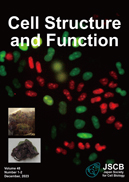
- Issue 2 Pages 31-
- Issue 1 Pages 1-
- |<
- <
- 1
- >
- >|
-
Asuka Hamamoto, Natsuki Kita, Siddabasave Gowda B. Gowda, Hiroyuki Tak ...Article type: Full Article
2024Volume 49Issue 1 Pages 1-10
Published: 2024
Released on J-STAGE: January 23, 2024
Advance online publication: December 09, 2023JOURNAL OPEN ACCESS FULL-TEXT HTML
Supplementary materialGaucher disease (GD) is a recessively inherited lysosomal storage disorder characterized by a deficiency of lysosomal glucocerebrosidase (GBA1). This deficiency results in the accumulation of its substrate, glucosylceramide (GlcCer), within lysosomes. Here, we investigated lysosomal abnormalities in fibroblasts derived from patients with GD. It is noteworthy that the cellular distribution of lysosomes and lysosomal proteolytic activity remained largely unaffected in GD fibroblasts. However, we found that lysosomal membranes of GD fibroblasts were susceptible to damage when exposed to a lysosomotropic agent. Moreover, the susceptibility of lysosomal membranes to a lysosomotropic agent could be partly restored by exogenous expression of wild-type GBA1. Here, we report that the lysosomal membrane integrity is altered in GD fibroblasts, but lysosomal distribution and proteolytic activity is not significantly altered.
Key words: glucosylceramide, lysosome, Gaucher disease, lysosomotropic agent
View full abstractDownload PDF (5759K) Full view HTML -
Daiki Kitamura, Kiichiro Taniguchi, Mai Nakamura, Tatsushi IgakiArticle type: Full Article
2024Volume 49Issue 1 Pages 11-20
Published: 2024
Released on J-STAGE: February 16, 2024
Advance online publication: January 11, 2024JOURNAL OPEN ACCESS FULL-TEXT HTML
Supplementary materialThe ribosome is a molecular machine essential for protein synthesis, which is composed of approximately 80 different ribosomal proteins (Rps). Studies in yeast and cell culture systems have revealed that the intracellular level of Rps is finely regulated by negative feedback mechanisms or ubiquitin-proteasome system, which prevents over- or under-abundance of Rps in the cell. However, in vivo evidence for the homeostatic regulation of intracellular Rp levels has been poor. Here, using Drosophila genetics, we show that intracellular Rp levels are regulated by proteasomal degradation of excess Rps that are not incorporated into the ribosome. By establishing an EGFP-fused Rp gene system that can monitor endogenously expressed Rp levels, we found that endogenously expressed EGFP-RpS20 or -RpL5 is eliminated from the cell when RpS20 or RpL5 is exogenously expressed. Notably, the level of endogenously expressed Hsp83, a housekeeping gene, was not affected by exogenous expression of Hsp83, suggesting that the strict negative regulation of excess protein is specific for intracellular Rps. Further analyses revealed that the maintenance of cellular Rp levels is not regulated at the transcriptional level but by proteasomal degradation of excess free Rps as a protein quality control mechanism. Our observations provide not only the in vivo evidence for the homeostatic regulation of Rp levels but also a novel genetic strategy to study in vivo regulation of intracellular Rp levels and its role in tissue homeostasis via cell competition.
Key words: ribosomal protein, proteasomal degradation, Drosophila
View full abstractDownload PDF (6140K) Full view HTML -
Kentaro Shimasaki, Yuko Okemoto-Nakamura, Kyoko Saito, Masayoshi Fukas ...Article type: Technical Note
2024Volume 49Issue 1 Pages 21-29
Published: 2024
Released on J-STAGE: June 22, 2024
Advance online publication: May 25, 2024JOURNAL OPEN ACCESS FULL-TEXT HTML
J-STAGE Data Supplementary materialCell biologists have long sought the ability to observe intracellular structures in living cells without labels. This study presents procedures to adjust a commercially available apodized phase-contrast (APC) microscopy system for better visualizing the dynamic behaviors of various subcellular organelles in living cells. By harnessing the versatility of this technique to capture sequential images, we could observe morphological changes in cellular geometry after virus infection in real time without probes or invasive staining. The tune-up APC microscopy system is a highly efficient platform for simultaneously observing the dynamic behaviors of diverse subcellular structures with exceptional resolution.
View full abstractDownload PDF (4248K) Full view HTML
- |<
- <
- 1
- >
- >|